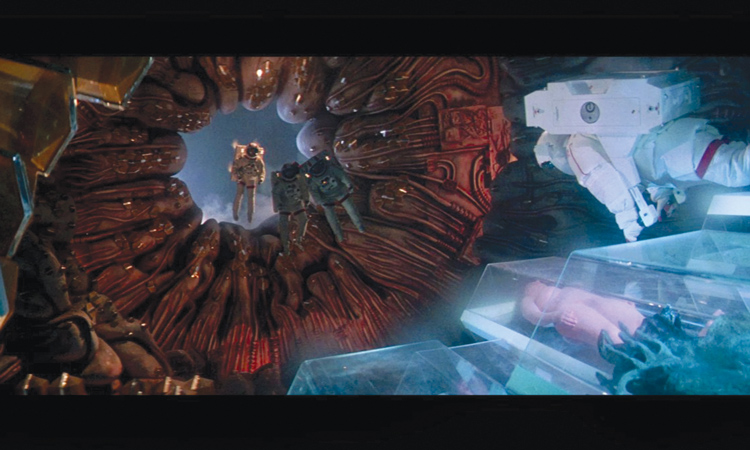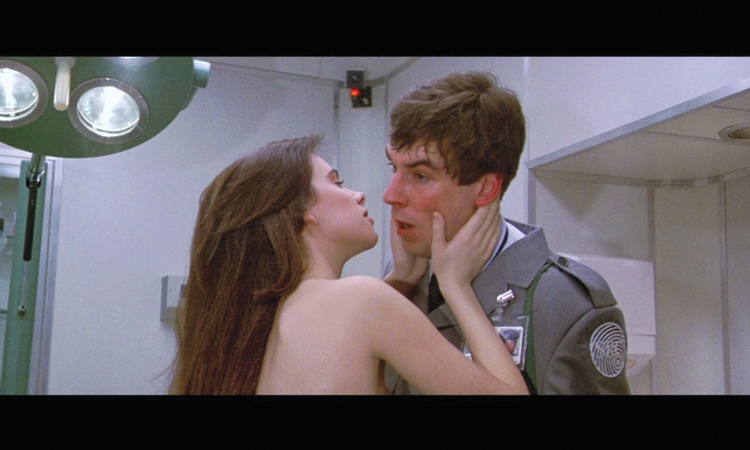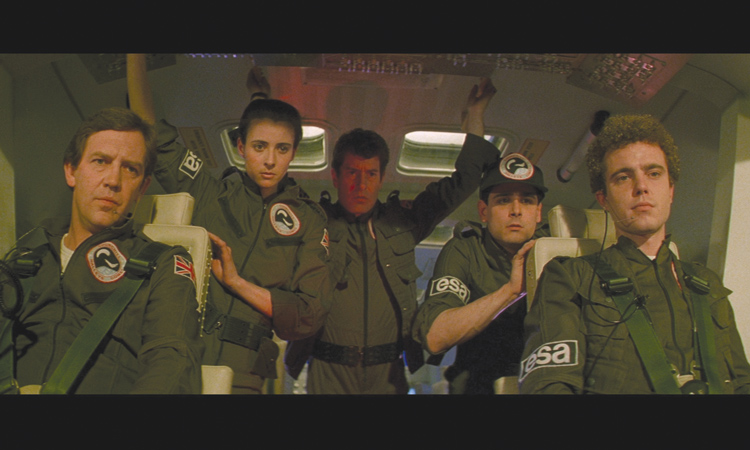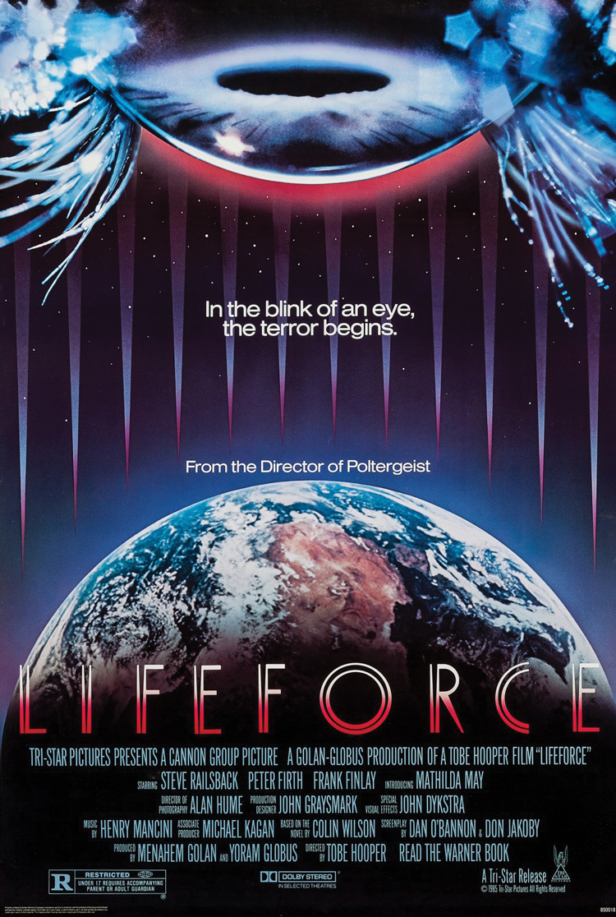Loosely based on the pulp novel The Space Vampires by Leicester-born author Colin Wilson, Tobe Hooper’s Lifeforce was deemed to be a surefire bet for summer box office success in 1985.
Backed by a mind-blowing budget that totalled $25 million (considerably more than was afforded to some of the year’s biggest hits, including Back To The Future and Ron Howard’s Cocoon), the endeavour was financed by the much-missed Cannon Films – eager to escape the schlock-merchant label by entering into a loftier field of high-concept genre cinema.
Hooper, at the time, also seemed like a safe bet. Whilst Poltergeist (1982) was rumoured to have benefited from the extensive involvement of producer Steven Spielberg, the creator of The Texas Chain Saw Massacre (1974) had, in truth, already shown his ability to navigate the mainstream with Universal’s cult classic slasher The Funhouse (1981) and the prime-time Stephen King adaptation Salem’s Lot (1979). And with distribution rights partly handled by Tri-Star Pictures, and a year-long shoot largely based at Elstree Studios in London, Lifeforce looked like the most ambitious and exciting Cannon Films project yet.
So how did it all go wrong?
“I think the biggest problem is that no one had any idea just how expensive it was going to be,” admits John Grover, the film’s editor, whose other credits include the likes of 2001: A Space Odyssey (1968) and the Bond classic Moonraker (1979). “Menahem Golan and Yoram Globus at Cannon were both heavies; old school producers who were quite intimidating. They certainly managed to get money in for their stuff – but it was never quite enough because they were making so many different movies at the same time. We had a lot of money for Lifeforce, but for the mid-Eighties we needed much more. This was a huge special effects film, which was trying to do things that no one had ever done before. And we had no idea how to put most of that together.
“I remember sitting in the cutting room with John Dykstra, trying to create the ‘lifeforce’ that leapt out from people’s bodies. And we physically scratched the film, every single frame, to try and make that work. And today it looks a little cheap, but it worked well for the time, and then John would take it over to Los Angeles and tirelessly try and do what he could with it, before the days of CGI. He was brilliant – but there weren’t many people in the UK who could do the sort of things he was doing out in Los Angeles at the time.”

Lifeforce is the story of a naked, buxom intergalactic space-femme, who arrives in London and begins to suck the souls out of anyone foolhardy enough to stand in her way. As Armageddon begins to arrive, and the dead start to crawl out of their tombs (often overlooked is the fact that Hooper’s movie is very much a zombie flick as well), MI5 and the city’s police force attempt to find the source of the evil. Flanked by a hallucinating American astronaut (played by Steve Railsback), a race-against-time ensues as Westminster and the surrounding areas fall into chaos.
A chaos, let it be said, that was aptly mirrored behind the scenes as well…
“I think Tobe was generally in control – he had good assistant directors around to help him,” mentions Grover. “But, yes, he had his problems, which people know about now, and he was often quite jumpy, let’s put it that way.
“A lot of the others who worked on the film were too. I don’t want to name any names, but there was a lot of drugs around. I did not use any, and many did not, but it was certainly present. I mean, it was the Eighties [laughs]. I thought Tobe had a lot of talent, though. I had seen The Texas Chain Saw Massacre and I absolutely hated it, but I did like Poltergeist. I got the impression he was trying to take the mood of Poltergeist, that big widescreen feel, and bring it to Lifeforce… but he was a nutcase [laughs]. At first he was shooting a lot of stuff that we could never use, so he had to go back and organise reshoots, which meant more money.
“There was [also] a lot of graphic nudity originally, a lot of focus on Mathilda May, who played the space vampire, without any clothes on. And that had to be cut or reshot because the angles that were there originally were just too graphic. I don’t know if Tobe had quite gathered that this was not his old X-rated films, like Chain Saw, but rather a big studio picture. Mathilda seemed to be enjoying herself though – she was having a good time and could not have been friendlier to everyone. She was very relaxed with or without her clothes on.”

Grover also shares some memories of Lifeforce’s remarkable effects work – particularly the climactic battle between the extra-terrestrial terror and what remains of London’s human population. Indeed, whatever one thinks of Hooper’s absurd space-opera, there is little denying that the final reel of Lifeforce is one of the most action-packed, lavish and creative of its decade – with explosions, monsters, blood and a giant vampire bat all thrown into the mix…
“Lifeforce had the same sort of budget, or maybe even a little higher, as the Bond films that I had done,” remarks Grover. “And we shot a lot of it in sequence. So we were heading to the end, when London has to explode under this alien invasion, and Tobe said: ‘Let’s blow up an entire soundstage.’ Which was insane [laughs].
“I think only Stanley Kubrick had set up an entire stage before and exploded everything that was on it. So Tobe set up a whole number of cameras and it was just amazing. It was so loud – and one of the cameras actually flew across the other side of the room [laughs]. The effect seemed to go on forever – and the great thing is that it all made it to the screen. It was brilliant. It was great fun. Or as Tobe would say to me: ‘John, this is creative art that are you seeing.’ I think he was having a great old time. Once he got into the flow of the film, Tobe did not waste a penny”
Clocking in at 128 minutes, however, the final cut of Lifeforce was faced with problems. Whilst today it might not be uncommon for a good, solid summer movie to stretch to three hours, in 1985 anything over two hours was deemed to be risky. For Cannon, the decision was cut and dry – Hooper’s hard work had to face the chop…
“Looking back, I think Lifeforce was an experimental film, which might sound crazy given the money, but it really was,” states Grover. “Tobe was really ahead of his time with this. I had done 2001 and Kubrick wanted that movie to be slow and epic and to feel real. Just as if you felt like you were in outer space. And Tobe wanted a little of that too – he wanted a strange film, but one grounded in reality and believable effects work. It had a slightly slow pace as well, but Cannon just did not want that. I thought that what we had in our final cut worked well but it was out of my hands. The big problem is that space is very slow, and the whole start of Lifeforce is in space. I could not speed that up in the editing suite, so that was the first thing that went. And it just went downhill from there. I felt when it came out in the cinemas that it was a disaster. It was cut right down to nothing. I certainly do think that is why it was a flop.”

Looking back all these years later, however, and Lifeforce has had its reputation rightly redeemed. Now seen as one of the last great movies to be shot on 70mm, and a true gem of the Cannon Films catalogue, Hooper’s ambitious sci-fi thriller undoubtedly altered the scope for digital special effects to progress into the Nineties and beyond…
“John Dykstra had won an Oscar for his work on Star Wars, and he was trying to establish himself as his own person at the time – mainly as the big name in visual effects,” remembers Grover. “And he did – he went on to really explore CGI a few years later, but he was right there, looking to the future with Lifeforce. We had good animatronic people in London, but a lot of what John wanted we didn’t have over here and nobody thought his suggestions could even be done. He was right at the cutting edge, so he did a lot of things himself over in Los Angeles afterwards and Lifeforce acted as his showreel. I think it was definitely a ground-breaking film for special effects.”
Not that the critics of the time saw it that way. Mauled by the leading writers of the day, Lifeforce became a byword for ‘bad’ during its brief stint at the theatres. In its truncated form, it seemed few could make heads nor tails out of the mayhem that unfolded and its fans were few and far between. Its lack of success also undoubtedly led to Hooper’s fast fall from grace. Signed to make two more Cannon catastrophes, his budgets were stripped and his follow-up films Invaders From Mars (1986) and The Texas Chainsaw Massacre Part 2 (1986) also bombed, amid talk of behind-the-scenes squabbling…
“Lots of the critics had their knives out, but this wasn’t a film that was made for the elite of the day,” laughs Grover. “I think maybe part of the problem was changing the name. It was meant to be called The Space Vampires until the final moment – when Cannon opted for Lifeforce. I think Tobe wanted it to stay as The Space Vampires, because it was aimed at a genre audience. You know, people who wanted popcorn, thrills and naked girls [laughs]. Actually, it was a huge hit in hotels. I wonder why anyone was ordering it in hotels back in 1985 [laughs]…
“But when I look at it today I think it is a really good movie, really well done. And what an incredible soundtrack from Henry Mancini. I remember thinking that was just first class – and the critics never picked up on that, which shows how useless they were back then [laughs]. We will all die, though, but Lifeforce – for whatever reasons – will live on.”
Lifeforce is available on Blu-ray from Arrow. Read our review here.
